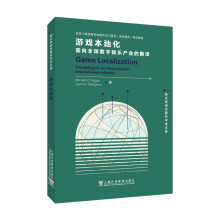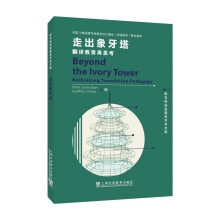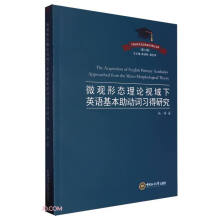










本书梳理了隐喻认知研究的历史,综述了不同历史时期、不同研究层面的有关隐喻实质和功能的理论,并指出了认知语言学家在隐喻认知研究中的分歧。本书从信息加工的全新角度深入探讨认知隐喻在工作记忆中加工的方式,提出了解决认知语言学家在隐喻认知研究中分歧的方案。作者将认知心理学理论和隐喻理论相结合,尝试阐释隐喻通过其认知机制正面影响记忆的方式,从理论上论证了隐喻对记忆的影响。以变量设计、语料设计、实验程序等尝试建构隐喻的认知加工模型,分析了隐喻参与工作记忆过程并促进记忆效果的原理。
Acknowledgements
Painful effort was expended in studying metaphor—the “pleasing mental effort” that makes things memorable, which involved the complex processes from choosing the topic, reviewing the literature, sorting out the experimental materials, carrying out the experiment, analyzing the data collected, concluding the findings and attempting to set up the model During these processes, those who offered direct or indirect help deserve sincere thanksThe completion of this book went through laughter and tears, based on the authors master dissertation and modified in years First and foremost, my sincere gratitude should go to Professor Liu Zhenqian, whose enlightenment, constructive suggestions as well as firsthand source on the studies of metaphor gave me great courage to complete the first original manuscript of this book I would express my special and heartfelt gratitude to my loving and affectionate mother, whose great love, help and support had enabled me to smoothly spend those tense months in struggling for the birth of the first manuscript of this book Although she is now in the peaceful heaven, unforgettable memory often brings me back to the years of happy time with her and the warm moments when she affectionately and softly called my name and asked me to go to sleep while I was typing on the keyboard at deep night She left and slept forever, but my miss and love for her is still growing with times gone by I also want to thank my father, my husband and my son for their love, support and encouragement they have been giving me in my academic pursuits all these years In the days of polishing the final script of this book, my dear father helped to take care of my son and my family, enabling me to have time to complete this book without worries and being pushed by daily chores Id like to thank my sensible and lovely son for putting cups of water on my desk when I was hard at work Id love to thank my husband, who often helped with the routine life at home without complaints even when he is busy with his workI also owe a lot to some of my friends, who gave me encouragement and understanding and helped to organize the participants and arrange the venue for the experiment Without their help, the experimental research could not have been completed Besides, I would also like to thank those scholars and authors at home and abroad whose books and research results I have consulted and obtained precious enlightenment fromGratitude and Love are woven in the lines of chapters All those who deserve my thanks contributed to the merits in this book, if any Surely, due to the insufficiency of my knowledge, any error that still exists is mine Any comments and suggestions for the improvement will be highly cherished Metaphor and Memory>>><<<PrefacePrefaceMetaphor is a mystery Metaphor is a charming ancient mystery that had attracted and has always been attracting many curious and intelligent pursuers and explorers The study of metaphor is as old as Aristotle, enjoying a long discussion Aristotle has already recognized the charming power of metaphor when he says “We learn above all from metaphors” Yet metaphor had been regarded as a rhetorical way by later researchers and had been treated as a rhetorical method for a long period of time With the publication of the book Metaphors We Live By by Lakoff and Johnson in 1980, the new cognitive approach further broadened our understanding to the nature of metaphorWhat is new about current cognitive trend is the strength of certain claims about metaphor and thought On metaphor and thought, most studies are concerned with comprehension of metaphors, yet it seems that part of what had been neglected by most scholars is the study of metaphor and memory, an important aspect in cognition research When metaphor made an acquaintance with memory in what place at what time, they at once fell in love with each other and danced a nice tango together, producing a pleasant melody and everlasting beauty in human cognition Put on the stage of cognition study, metaphor may have found her right place, exerting great influence on human cognition However, the very pleasant melody and everlasting beauty metaphor produced in human memory have been neglected by human ears and eyes, and the role of metaphor in memory was sometimes slightly mentioned without being highlighted In fact, metaphor with its beauty and charm influences memory in many ways, and our memory also especially cherishes metaphorical expressions in its deep heart While, on the issue of metaphor comprehension, there are primarily two opposite trends: Glucksbergs Attributive Categorization View (ACV) and Lakoffs Conceptual Metaphor Theory (CMT) Around the two different views, different experimental researches have been done by McGlone et al(for ACV) and Gibbs et al(for CMT)Their debates seemed incompatible, but they both agreed on the role of metaphor in cognition Hoping to settle the debate, this book aims to further study role of metaphor in memory in the frame of information processing to lead the two separated roads to one way: role of metaphor in cognition suggested by role of metaphor in memory The argument is settled in the framework of MUC theory From the perspective of information processing, this book mainly explores the cognitive function of metaphor, and tries to establish a model of metaphor cognition and processing Based on cognitive theory, memory theory and Lakoffs conceptual metaphor view, following previous experimental studies, the research in this book mainly focuses on the cognitive role of metaphor in memory, aiming to suggest that metaphor facilitates memory and cognition at certain degree, exploring the role of metaphor in memory with respect to Chinese learners of English as a second language (ESL) The whole book contains nine chapters Chapter 1 introduces intellectual history of metaphor study with especially cognitive approach highlighted, current interest and method of this study concerning metaphor and memory and the framework of this book Chapter 2 makes an overview of metaphor theories about nature and function of metaphor at different levels in different periods Chapter 3, from the perspective of information processing, further analyzes cognitive metaphor processing in memory, solving the heated debates between CMT and ACV views about metaphor in cognition Information processing of metaphor in memory paves the way for the establishment of Cognitive Processing Model of Metaphor in Chapter 8Chapter 4 attempts to combine cognitive psychology theories and metaphor theories to elaborate how metaphor influences memory, illustrating that metaphor may influence memory through its working mechanisms This part makes a theoretical exploration of the positive role metaphor plays in memory and sets theoretical basis for the experimental research in this book and makes possible the further study in subsequent chaptersChapter 5 reviews previous experiments, sorting out, analyzing and discussing the previous experimental studies concerning cognitive function of metaphor By analyzing and commenting on the previous experimental methods and results, this chapter affirms the feasibility of carrying out the experiment in this studyChapters 6 and 7 deal with the experimental researchChapter 6 is methodology, expatiating the rationale of the experiments, the objectives and hypotheses of the experiment, variables, materials and design of the experiment as well as the explicit procedure And Chapter 7 is about the results and discussions of the data collected, and by analyzing the data and the results, this chapter concludes the findings from the experiment Chapter 8 focuses on the attempt to construct Cognitive Processing Model of Metaphor, revealing the nature of metaphor processing, illustrating how metaphor takes part in working memory process to enhance memory effect in human cognition, and pointing out the brain regions activated in different processing stages, taking a cognitive neurolinguistic perspective in metaphor study Chapter 9 concludes the chapters, summarizes the theoretical assertion, experimental findings and the significance of Cognitive Processing Model of Metaphor proposed in this book, points out the implication and limitations of this study and makes a suggestion for future researchThe creation of this study lies in theoretical exploration (Chapter 3, Chapter 4 and Chapter 8) and the experiment research (Chapter 6 and Chapter 7), theoretically attempting to explore metaphor interpretation in information processing view at cognitive level and experimentally testifying the positive role of metaphor in memory and cognition And the cognitive processing model of metaphor is proposed, leading to a direction of metaphor study This book, on the one hand, inherits the basic standpoint of contemporary cognitive linguistics about metaphor, and on the other, differs from the previous research style on study of metaphor Referring to the theories and methodologies of cognitive science, especially cognitive psychology about human memory and information processing, this book, not only theoretically analyzes the relationship between metaphor and memory, but also creatively explores the cognitive function of metaphor in memory by way of experimental research Metaphor and memory dance a nice tango in human cognition, constructing a cognitive model of metaphor processing As long as human cognition stands, the beauty and nice melody they produce together will be everlasting
Shao ChanghongJinan, ShandongMay 2020
Chapter 1 Introduction
11Prologue
12Intellectual History of Metaphor Study
13Current Interest and Method of This Study
14The Framework of This Book
Chapter 2 Theories on Nature of Metaphor
21Aristotle and Metaphor
22Traditional Theories of Metaphor
23Creative Theory
24Cognitive Theories of Metaphor
25Chapter Summary
Chapter 3 Cognitive Metaphor and Memory in IPS
31Metaphor Interpretation in Cognitive Linguistics
32CMT and ACV Views about Metaphor in Cognition
33Metaphor Interpretation and Memory
34Information Processing of Metaphor
35Chapter Summary
Chapter 4 Memory and Working Mechanism of Metaphor
41Metaphor and Memory
42Working Mechanisms of Metaphor and Memory Improvement
43Metaphor Affecting Memory though Cognitive Assimilation
44Chapter Summary
Chapter 5 Previous Experimental Studies on Metaphor Comprehension and Memory
51Previous Research on Metaphor Comprehension
52Previous Research on Metaphor and Memory
53Chapter Summary
Chapter 6 Methodology
61Research Questions and Hypotheses
62Rationale of the Research Design of Current Study
63Participants
64Materials
65Procedure
66Data Collection
67Data Analyses
68Chapter Summary
Chapter 7 Results, Discussion and Findings
71Results
72Discussion
73Major Findings
74Chapter Summary
Chapter 8 Cognitive Processing Model of Metaphor
81Working Memory
82MUC Theory
83Cognitive Metaphor Processing Based on MUC Theory
84Cognitive Processing Model of Metaphor Proposed
85Chapter Summary
Chapter 9 Conclusion
91Theoretical Assertion
92Experimental Findings
93Significance of Cognitive Processing Model of Metaphor
94Implication and Application of This Study
95Limitations of the Present Study and Suggestions for Future Research
Bibliography
温馨提示:请使用德清县图书馆的读者帐号和密码进行登录